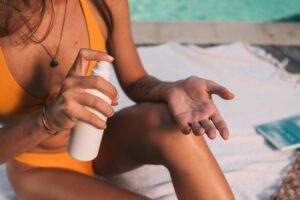Sunscreen Guide 2025: How to Choose, Apply & Protect Your Skin Effectively
✅ “This sunscreen guide will help you understand how to choose, apply, and protect your skin with SPF.”
you’re heading to the beach or simply walking to work, sunscreen is one of the most essential skincare products you should never skip. But do you really know how to use it properly? Or which SPF is best for your skin type?
This guide covers everything you need to know about sunscreen, including what it is, how it works, and how to choose the best one for your needs.

☀️ What is Sunscreen and How Does It Work?
The Ultimate Sunscreen Guide: Protect Your Skin with Confidence
Sunscreen is a skincare product that protects the skin from the harmful effects of ultraviolet (UV) radiation. It contains active ingredients that either absorb or reflect UV rays, preventing them from penetrating the skin.
There are two main types of UV rays:
UVA: Causes aging and wrinkles.
UVB: Causes sunburn and increases the risk of skin cancer.
Broad-spectrum sunscreens protect against both.
🧪 Types of Sunscreen: Chemical vs. Mineral
Chemical Sunscreen: Absorbs UV rays and converts them into heat. Often lightweight and suitable for daily wear under makeup.
Mineral Sunscreen (aka physical): Uses ingredients like zinc oxide or titanium dioxide to reflect rays. Ideal for sensitive skin or children.
Each has its pros and cons, and choosing the right one depends on your skin needs and preferences.
🧴 How to Choose the Right SPF
SPF stands for Sun Protection Factor. Here’s how to decide:
SPF 15: Blocks about 93% of UVB rays (best for low exposure)
SPF 30: Blocks about 97% (good for daily use)
SPF 50+: Blocks about 98%+ (recommended for fair or sensitive skin)
Pro Tip: Higher SPF doesn’t mean you can apply it once and forget. Reapplication is key!

🕒 When and How to Apply Sunscreen
Apply 15–30 minutes before sun exposure
Use 1 teaspoon for face and neck
Reapply every 2 hours or immediately after swimming/sweating
Don’t forget spots like ears, lips, hands, and feet!
🌤️ Sunscreen for All Seasons
Many people think sunscreen is only for summer, but UV rays are present year-round—even on cloudy or snowy days. Make sunscreen part of your daily routine, especially if you’re using skincare with actives like retinol or acids.
🧴 Sunscreen and Makeup: Can You Combine?
Yes! Choose:
A lightweight sunscreen that works as a primer
SPF-containing foundation (though not enough on its own)
Reapplication options like SPF sprays or powders over makeup
🧼 How to Remove Sunscreen Properly
Wearing sunscreen is important—but so is removing it. Many sunscreens are water-resistant, which means regular cleansers might not fully remove them.
Here’s how to do it right:
Use an oil-based cleanser or micellar water as a first cleanse
Follow up with a gentle face wash
Avoid harsh scrubs that damage the skin barrier
Proper removal helps prevent clogged pores and breakouts.

🧒 Can Children Use Regular Sunscreen?
Babies under 6 months should avoid sunscreen altogether and be kept in the shade. For children over 6 months, mineral sunscreens with zinc oxide or titanium dioxide are safest.
Avoid:
Chemical sunscreens with oxybenzone
Fragrances and dyes
🔁 Sunscreen Myths You Should Stop Believing
Let’s bust a few common myths:
“I don’t need sunscreen indoors.” UV rays can pass through windows.
“Darker skin doesn’t need sunscreen.” All skin types are vulnerable to UV damage.
“One application lasts all day.” You need to reapply every 2 hours.
☀️ How Often Should You Reapply Sunscreen?
Reapplying sunscreen is just as important as applying it in the first place. Even the most powerful sunscreen can wear off over time — especially due to sweating, swimming, or simply spending long hours in the sun. As a general rule:
Every 2 hours: Reapply if you’re outside continuously.
After swimming or sweating: Use a water-resistant sunscreen and reapply immediately after drying off.
Even indoors: If you’re near windows or using screens for long periods, light can still affect your skin.
Don’t forget often-missed areas like your ears, neck, hands, and feet — they’re just as vulnerable.
🧴 How Much Sunscreen Should You Use?
Most people underapply sunscreen. To get the full protection promised by the SPF label, you need to use the right amount:
For your face and neck: Use about a nickel-sized amount.
For your whole body: Use around 1 shot glass (approximately 30ml or 1 ounce).
Don’t forget your lips — use a lip balm with SPF.
Using too little drastically reduces effectiveness. Think of it as your skin’s daily armor.
☁️ Do You Really Need Sunscreen on Cloudy Days?
Yes — UV rays penetrate clouds. In fact, up to 80% of UV rays can pass through on overcast days. This means your skin is still exposed even if you don’t feel the sun’s warmth.
Daily sunscreen use is not just for the beach — it’s part of a long-term strategy to prevent aging, hyperpigmentation, and skin cancer.

🌍 Choosing an Eco-Friendly Sunscreen
Protecting your skin shouldn’t harm the environment. Many traditional sunscreens contain chemicals like oxybenzone and octinoxate, which are harmful to coral reefs. Instead:
Look for reef-safe labels.
Choose mineral sunscreens with zinc oxide or titanium dioxide.
Avoid aerosol sprays that can pollute air and water.
This small change helps preserve the ocean while keeping your skin safe.
🌿 Final Thoughts
Sunscreen isn’t just a beauty product—it’s a powerful defense against premature aging, dark spots, and even skin cancer. Make it a non-negotiable part of your skincare routine.
Your skin will thank you later
If you’re building a full skincare routine, don’t miss our daily skincare guide.
https://pureskinsecret.com/daily-skincare-routine/
SPF 30 blocks about 97% of UVB rays. For more tips on choosing and applying sunscreen, refer to this expert guide.
https://www.aad.org/public/everyday-care/sun-protection/sunscreen